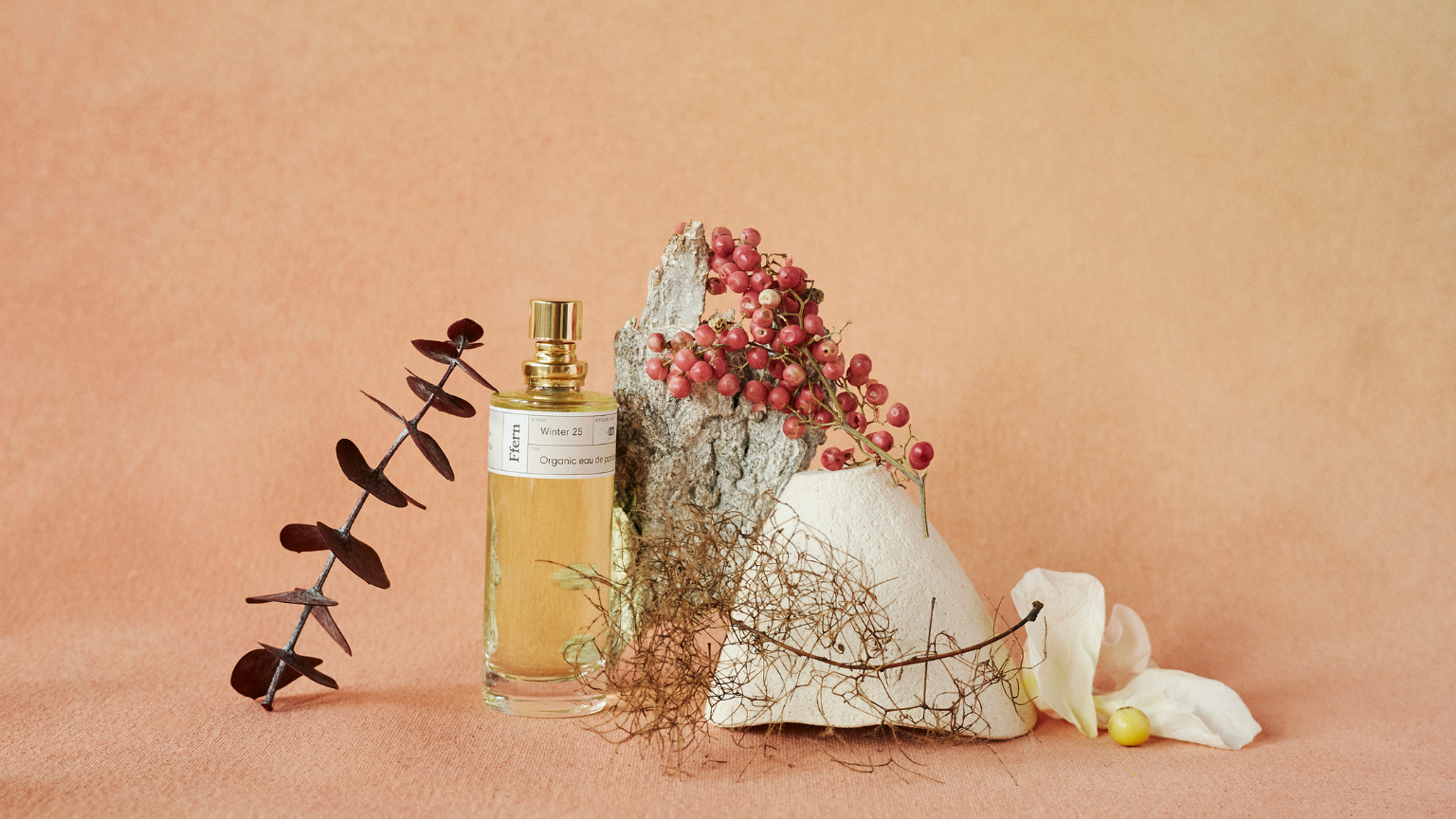
When I arrive in San Antonio, I expect to encounter “bigger in Texas.” What this trip is really about, I soon learn, is slower in Texas. As I walk up the front steps of a well-shaded 100-year-old brick building that headquarters Cultus Artem—a niche fragrance studio housed in a former Southwestern Bell telephone exchange—a small vintage plaque by the doorbell reads: “Please Ring Bell. And Wait.”
On an unseasonably cold day, I sit with Cultus Artem founder Holly Tupper and her small team of four at a large dining table in the center of the office for a family-style lunch. The industrial space is perfectly styled with antique finds from Tupper’s world travels—she also designs and creates Cultus Artem skincare and one-of-a-kind fine jewelry here. Sun beams through the original 10-foot windows onto the beautiful spread: salmon, gourmet cheeses, warm rolls, and a fresh green salad. No laptops in sight, no phones out save for mine recording our discussion. I assume the relaxed meal is specially prepared for my visit, but quickly learn that this is, in fact, standard operating procedure: make and share meals together, away from screens and Slack messages, a few times a week. Fittingly, the Cultus Artem chemist, Danya Batallas, also makes the salad dressing.
“It’s just olive oil, apple cider vinegar, and mustard,” Batallas tells me. “We joke that it’s kind of like a large-scale manufacturing project because we go through so much. This is the only large-scale product we have in the house.”
Cultus Artem, which can be found at Bergdorf Goodman, is a 10-year-old luxury brand of only eight fragrances and less than one new launch a year. Each is inspired by unusual scents from Tupper’s travels and years living in Southeast Asia—Champaca, for example, is an otherworldly white floral that was inspired after jogging through an old abandoned cemetery in Singapore; Ilex is a “hot citrus-like sunrise” of smoky green tea with animalic jasmine and powdery iris inspired by playing polo. Having trained at The Grasse Institute of Perfumery in France, Tupper is the nose behind her own fragrances, mixing at a small fragrance organ in her studio on the second floor.
“The point of being an artist is not to distribute your artistic vision to somebody else, to interpret it on your behalf,” says Tupper. “It's my vision and the making process is as interesting to me as the creative process."

Throughout a basement and three stories, the building is carved into a laboratory, production facility, creative offices, and invitation-only showroom all under the same roof. As a journalist who has toured the facilities of many beauty companies—the ones you see sold at Sephora and Nordstrom—I can tell you this is not the norm. While fragrance is an emotionally-driven art of the unseen, the production process is technical, tedious, and usually done en masse. The process inside Cultus Artem, where each bottle is hand-poured, packaged, and shipped, is an approach that fits right into the growing trend of slow fragrance and its budding umbrella category slow beauty.
What Is Slow Fragrance?
Slow fragrance started setting off my beauty reporter spidey senses right as fragrance seemed to hit impossible popularity on PerfumeTok and in industry headlines. The brands that embrace the practice speak up about ethical sourcing and a return to the intentional artisanal practices that defined luxury fragrance before the explosion of celebrity beauty brands and viral must-haves on social media. While the emerging term is not yet tightly defined like its predecessor movements slow food and slow fashion, a growing cluster of brands promote a rejection of mass production in favor of thoughtful craftsmanship, even if it means restricted production volume. The viral UK-based brand Ffern, for example, sticks to “traditional, small batch production processes—reducing waste and ensuring we can source the finest natural ingredients in exact quantities,” according to brand literature. They are constantly sold out.
While big designer fragrance houses like L’Oréal and LVMH also lay claim to improving ethical practices—as all the major fragrance houses have sustainability goals listed on their websites—it is rarely a marketing point for the typical shopper (though Mintel reports that 75% of consumers say sustainability influences their purchases). And in regard to reducing quantity of consumption especially, slow fragrance’s minimalism certainly goes against the tide.
The fragrance market today is glutted with new launches with roughly 200-plus fragrances launching every year from mass brands, celebrities, and fashion houses. Fragrance accounted for 15 percent of overall prestige beauty spending in 2024 according to Daash. Last year alone, perfume sales rose 12 percent to $9.5 billion in the US, with luxury fragrance up 43 percent per Circana. So, as fragrance layering and multi-shelf collections become de rigueur on social media, one naturally wonders just how many scents—supposedly so personal and intimate a purchase—are reasonable for one person to own. And if this pendulum is ready to swing in the other direction.
What Is Behind the Slow Fragrance Movement?
“I think there’s a backlash to consumerism,” says Tupper. “What makes more sense is to go back to what luxury used to be, which was luxury that is rare, and less about this big publicly-held company version of what luxury is.”
As romantic as it is, this philosophy also means doing things the hard way. Batallas creates every bottle by hand, working with Tupper in a process that can take years to bring a new scent to market and painstaking hours of complicated safety compliance paperwork. This makes them outliers even in the indie industry, where most small brands outsource formulation, production, and regulatory processes to large contract manufacturers. And while most commercial fragrances rely heavily on synthetics that can be much cheaper, Tupper uses a high percentage of natural ingredients, many sourced from small family-owned farms, she says.
“I once visited one of the largest contract filling companies in the country,” says Tupper, who worked in finance early in her career. “The process they go through just to prime the pumps of their bottling machinery requires huge amounts of undiluted perfume—it would have cost us $300,000 just to prime the pumps before we even had the first bottle. Then it goes into their watershed and then goes where?"
There’s no question that a slower, more considered approach should be a central concern for the fragrance industry.
Emily Cameron, Ffern creative director
Like slow fashion and slow food, an obvious caveat to slow fragrance is indeed the price tag. While your average popular luxury fragrance is around $150 to $200 (or over $300 for the famed Maison Francis Kurkdjian Baccarat Rouge 540), Cultus Artem ranges from $225 to $580. This is mainly because of the cost of natural ingredients. For example, natural orange blossom is about $9,000 a kilo and narcissus is about $30,000 a kilo, Tupper tells me, but instead of using a much cheaper synthetic replacement, which is common practice, she creates an accord with other natural scents to mimic the pricier materials. The final product is certainly not an impulse buy.
Globally, slow fragrance is gaining attention and traction with independent perfumers speaking up about similar slow philosophies in their own unique ways. In Australia, Craig Andrade of The Raconteur—which lists slow fragrance in its brand manifesto—left a successful law career to pursue perfumery after a transformative experience with natural fragrances. A nose for Troy Sivan’s fragrance label, Andrade is also in the process of opening his own sustainable farms of native plants from which he’ll begin to source his materials. Fueguia 1833, which is based in Italy—the birthplace of slow food—produces fragrances in small batches, each numbered like limited-edition art prints. Every aspect of the fragrance creation is done in-house with a strong emphasis on ingredient traceability, explains founder Julian Bedel. “Because we use natural ingredients, every time we produce something, each edition is slightly different.” On occasion, he says, if an ingredient can’t be harvested sustainably, they forgo producing it.

Back in the US, the New York City-based brand Ourside formulates and produces their highly edited library of three scents in small batches in the Bronx. “For us, slow fragrance means creating scents with care, not urgency, and making every launch meaningful,” says founder Keta Burke Williams, whose brand has also been tapped by Bergdorf Goodman.
A darling of the movement, the aforementioned Ffern takes a seasonal approach, releasing just four seasonal limited-edition fragrances a year available only to members on their waitlist. “There’s no question that a slower, more considered approach should be a central concern for the fragrance industry,” says Emily Cameron, Ffern’s creative director. “The amount of waste that perfume and its packaging generates is something we’ve resisted from the beginning.” Ingredient-wise, Cameron says, transparency and sustainability are key—for example, their sandalwood comes from newly cultivated groves in Australia rather than from threatened wild forests in India, she says. And each Ffern scent is delivered in a plain stock bottle with no cap and recyclable cardboard packaging wrapped in compostable cellophane.
What Does the Future Hold for Slow Fragrance?
Naturally, as these niche brands become more coveted, the pressure to produce more follows, but there are signs that consumers will continue to desire more slow fragrance and slow beauty. Andrew McDougall, director of beauty and personal care at market research group Mintel, calls it Think Slow, Move Fast: Less Clutter, More Impact in his 2025 trend predictions. And indie beauty brands like Kindred Black, Fara Homidi, KraveBeauty, Cult of Reason, Ember Wellness, and SpaRitual are beating the drum of slow beauty in skincare and makeup.
Over the lunch table at Cultus Artem, the plates have been cleared and the conversation moves between sustainability, AI in fragrance, chocolate farming, and Tupper’s newest project, her first home fragrance: a refillable porcelain candle vessel handmade and handpainted in Portugal. It’s ornate, delicate, and timeless—seemingly untethered from social media aesthetic trends. “I’ve been working on this for five years,” says Tupper. “I am making things that I want in my life that I truly can't find.”
In an age wherein “instant gratification” is almost too late, when the white noise of constant consumption can blind us from the original reason we clicked “buy” to begin with, there’s something relieving about a pause, a slow down, and an appreciation of the moment. This is especially so for the transportive, meditative art of fragrance—the sense most directly tied to emotion and memory center of our brains. Good things take time. Please ring bell. And wait.
Shop Slow Fragrances
Why Trust Marie Claire
For more than 30 years, Marie Claire has been an internationally recognized destination for news, fashion, and beauty trends, investigative packages, and more. When it comes to the products Marie Claire recommends, we take your faith in us seriously. Every product that we feature comes personally recommended by a Marie Claire writer or editor, or by an expert we’ve spoken to firsthand.







